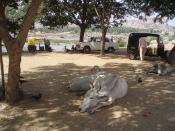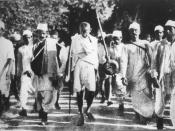Overall view of India's economy Great overall objective look. Must get more descriptive within the Industry.
Around 2000 B.C. people called Aryan started invading India. This process continued to approximately 1000 B.C. Aryan tribes were led by kings. The Aryans conquered the native population, intermarried with it and settled in peasant villages.
The Aryans brought their religion to India. The various sacrifices of the Aryan cults were accompanied by chanted hymns. These hymns comprised the first great religion work of the Aryans - the Rig Veda. The Veda and the Brahmins, the priests, came to hold a most prominent place in Vedic society.
By about the forth century B.C. Hinduism had supplanted the older Vedic faith and became supreme. During this period two new religions Buddhism and Jainism developed out of Hinduism. The basic institution of the society was the extended family. The family consisted of eldest male and his wife, their sons, grandsons and heir wives and children and unmarried daughters.
The majority of Hindu families lived in villages and agriculture was their basic occupation.
When Aryans settled in India, their society was organized around four varnas or orders. Brahmans (priests) were the highest varna. The second varna consisted of the Kshatriyas or warriors, rulers and administrators. The third varna consisted of the Vaishya or merchants. The Shudras belonged to the lowest varna. During classic period, hundreds of sub-varnas, jatis, developed. Membership in a caste was determined by birth and Hindus were not allowed to marry members of other castes.
The village was governed by its headman and a council. Both were members of highest caste in the village. Villages compose kingdoms and empires which were ruled by monarchs.
In 1018 A.D. Mahmud of Chazhi invaded India from Afghanistan. This was the date when Muslims started to rule India.



It a good analyse
not suprisingly good, but not bad either
11 out of 11 people found this comment useful.